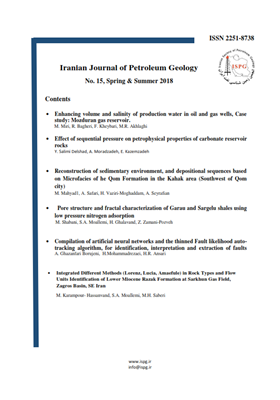-
-
List of Articles
-
Open Access Article
1 - Enhancing volume and salinity of production water in oil and gas wells, Case study: Mozduran gas reservoir
rahim Bagheri Mehdi Miri Farshid khabiri Mohhamadreza Akhlaghi -
Open Access Article
2 - Effect of sequential pressure on petrophysical properties of carbonate reservoir rocks
Ali Moradzadeh yaser Salimidelshad Ezatollah Kazemzadeh abbas Majdi -
Open Access Article
3 - Reconstruction of sedimentary environment, and depositional sequences based on Microfacies of the Qom Formation in the Kahak area (Southwest of Qom city)
Mahdiyeh Mahyad Hosyen Vaziri moghadam -
Open Access Article
4 - Pore structure and fractal characterization of Garau and Sargelu shales using low pressure nitrogen adsorption
Seyed Ali Moallemi Mohammadebrahim Shabani Hormoz Ghalavand Ziba Zamani Pozveh -
Open Access Article
5 - Compilation of artificial neural networks and the thinned Fault likelihood auto-tracking algorithm, for identification, interpretation and extraction of faults
Alireza Ghazanfari Hoseyn Mohammadrezaei Hamidreza Ansari -
Open Access Article
6 - Integrated different methods (Lorenz, Lucia, Amaefule) in rock types and flow units identification of lower Miocene Razak Formation at Sarkhun gas field, Zagros basin, SE Iran
Mohammad Hossein Saberi Milad Karampour.Hasanvand Seyed Ali Moallemi
-
The rights to this website are owned by the Raimag Press Management System.
Copyright © 2017-2026







